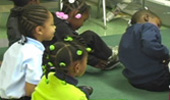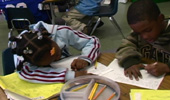| SEND FEEDBACK ABOUT THIS WEBSITE! |
Independence in a First Grade Classroom
Gillian Maimon , Powel Elementary School
Philadelphia, Pennsylvania
Content
What are my students learning?
Teaching Practice
What's my approach?
| Physical Structures | Time Structures |
|---|
How do I simultaneously provide the structure and freedom to create both independence and collaboration in a literacy-rich classroom? |
||||||||||||||||||
One of my priorities as a first-grade teacher is to facilitate both independence and collaboration among my students. Predictability is key to achieving this goal. The structures in place in my classroom allow children to make choices and help shape the content of their literacy learning. There is an element of predictability to the physical, linguistic, and temporal structures in the classroom. In addition, I give careful thought to ways that curricular structures—both self-selected frames as well as mandated ones—shape my own choices as a teacher. |
||||||||||||||||||
|
||||||||||||||||||
Welcome to Room 204. Writing workshop is the first activity in a day packed with literacy learning. As with every activity in my classroom, I aim for writing workshop to be simultaneously intellectually free, and carefully structured. Here are video examples of writing workshop and some explanation of how I think about different aspects of the structure of this activity. These structures and how they are embedded in literacy learning in the classroom are expanded upon in the pages of the website. |
||||||||||||||||||
The physical structure of this activity The physical structure of writing workshop makes use of key spaces in the room in multiple ways. The rug is both the site of the opening and closing whole-group discussions, and one of the spaces in which children can sprawl informally when engaging in the independent portion of the work. Children make use of nearly every corner at the independent writing time, from the reading corner, to the tables, to little hidden nooks under the computer table. Clearly, there are different movement expectations at different times in the writing workshop. Mobility is as much the norm at independent work time as fixed placement is at the formalized rug instruction. |
||||||||||||||||||
The time structures of this activity Several time structures are evident in the routine of writing workshop. First, there is the structure of recurrent time, or time of day. I choose to schedule writing workshop first thing in the morning in part because of my long experience that children arrive at school brimming with stories to tell. Rather than needing to silence the stories so that the work can begin, I am able to invite the children to make the stories the work. |
||||||||||||||||||
Another factor in this timing choice is the reality at my school that not every child arrives at school on time, nor does every child arrive fed. Writing workshop is easily joined in-progress, for it is a self-sustaining activity. Ideally, I would have my entire class present for every moment of writing workshop, from the mini-lesson on. But for those who trickle in late, they need only look through their writing folders to know what it is that they need to do next. Second, there is the structure of immediate time. Within the approximately forty-five minutes of daily writing workshop, about the first ten minutes is spent on the mini-lesson—what in my classroom we call the writing conversation. In this mini-lesson, I am teaching the children the concept of point of view, and issuing the challenge, to anyone who wishes to take it, to write from a point of view other than their own. Following the mini-lesson, the children have approximately twenty-five minutes for free writing. Finally, children who have taken the day's challenge are invited to share for about ten minutes. Third, there is the structure of long-term time. Our approximately every-four-to-six-week writing celebrations are important landmarks in the pacing of each unit of study we undertake during writing workshop. I look ahead to these publication events in order to plan the progression of lessons that I teach to the children, and I regularly call to the children's attention these dates on the horizon in order that they have a sense of where their work is headed. |
||||||||||||||||||
|
||||||||||||||||||

